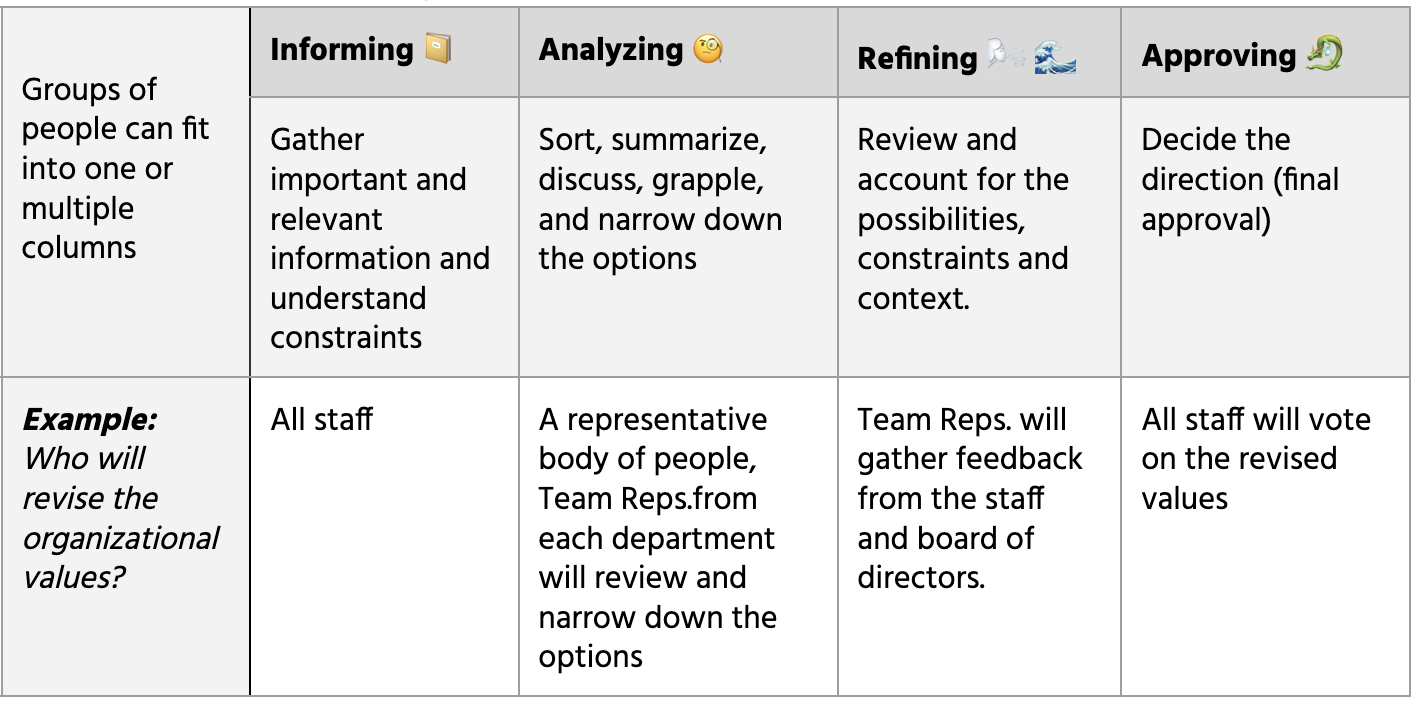AN IMPORTANT DECISION-MAKING TOOL
When people work together, an inevitable tension surfaces: How do we make decisions and who makes them? Colibrí has realized that many teams don’t have explicit or transparent decision-making protocols or tools. Some teams create a new and different decision-making process every time they have to decide something. Others avoid making decisions or taking action for fear of excluding team members. And others defer decision-making to the people in the room when decisions are discussed. These methods of decision-making are not transparent, leaving teams feeling confused and disempowered. Additionally, they default power to those with privilege or positional authority in the organization and not necessarily those who have the expertise or are impacted by the decision.
A Spectrum of Influence
We created the Spectrum of Influence, a graphic organizer, to name the parts of a decision-making process and establish who is engaged and how. Teams working with the spectrum have increased trust and become more adaptive as challenges or opportunities arise. The spectrum, along with our accompanying readings and activities were inspired by A Facilitators Guide to Participatory Decision-Making by Sam Kaner with Lenny Lind, Catherine Toldi, Sarah Fisk and Duane Berger, Rosa Gonzalez’s Spectrum of Community Engagement and Ownership, and The Dawn of Everything by David Graeber and David Wengrow.
Decision Making is a Practice
We begin the conversation about decision-making by exploring the types of power and our relationship to power. These conversations are the foundation for establishing a decision-making process that acknowledges and moves power. Then, we practice using the spectrum as a guide, beginning with the larger decisions about the organizational identity, values, vision, mission, etc. Later, teams identify decisions where they feel stuck or use the spectrum to revisit previous decisions that have surfaced tensions. These decisions are described in the left-hand column of the spectrum, and next to it, we define who is engaged in the aspects of decision-making. The conversations that take place as we review and revise are where we gain clarity.
We make the implicit explicit and decide where things need to change in their decision-making orientation:
Informing: Who can guide the decision by providing essential information? Who is most impacted and has the most context? What constraints exist? In this phase we encourage divergent thinking and bountiful possibilities.
Analyzing: Who can take the information and grapple with the options to categorize or eliminate options moving forward? This is the most challenging aspect of decision-making because discussions may not feel complete with a closed ending.
Refining: Who understands the underlying resource constraints, possibilities and context in order to assess the options and refine the proposal? We might return to the informing stage to gather more input. The process can be iterative.
Approving: Who will approve and memorialize the decision? We strongly encourage updating team members or the community along the way.
By practicing and using this tool, teams identify patterns in their decision-making. These patterns guide future decision-making processes.
Decision-Making as Liberation
“How we are at small scale is how we are at the large scale.”
-adrienne maree brown, Emergent Strategy
We use the book The Dawn of Everything by David Graeber and David Wengrow that provides lessons from pre-colonial indigenous communities (many still exist) and challenges our assumptions about human history and the self-organized governance or decision-making from this region. These communities established a wide diversity of decision-making models for small bands of people to large metropolitan areas that dwarfed Roman cities. Graeber gives examples of decision-making/governance models that were values-driven, self-aware, and adaptive, sometimes returning to previous models after trying new ones that no longer served the community. See examples and resources in the addendum below.
Defining your decision-making on a small scale is self-governance. Those of us who work for something vastly different must prepare ourselves and others for what is on the other side of change. As we work towards it, we must become that change. Practicing and working for that future by creating transparent and explicit self-governance models that are self-aware and adaptive is walking the path of liberation.
Addendum:
The Osage people of the region in the Ohio River Valley were not attached to a single model; they would restructure their social order and decision-making to meet their community needs, calling it “moving to a new country” as a symbol of constitutional change. To learn more, listen to two examples of governance structures from the Nambikwara (begin listening at the 57-minute mark, about a 6-minute listen) living in what is known now as Brazil, who developed two governance structures depending on seasons in Brazil and Teotihuacan (about a 13-minute listen).
Image Description:
The image above is of nautilus shells. We chose nautilus shells because they represent a pattern that repeats and becomes larger in each iteration. As the structure’s size increases, the shape of the pattern remains the same. This fractal is a symbol for the quote by adrienne marree brown: How we are at small scale is how we are at the large scale.
*We appreciate the wisdom and movement The Nap Ministry has unfolded and recommend others to follow.


